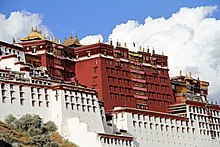티베트 (1912년~1951년)
보이기
(티베트 왕국에서 넘어옴)
이 문서는 위키백과의 편집 지침에 맞춰 다듬어야 합니다. (2023년 12월 6일) |
| 티베트 | ||||
|---|---|---|---|---|
| བོད་ Bod | ||||
| ||||
| 국가 | 승리의 노래 | |||
 1942년 티베트의 영토 범위 | ||||
| 수도 | 라싸 | |||
| 최대도시 | 수도 | |||
| 정치 | ||||
| 정치체제 | 이원집정부제;[1] 선거군주제 절대군주제[2] | |||
| 입법부 | 없음 (법령) | |||
| 지리 | ||||
| 면적 | 1221600 km2 | |||
| 인문 | ||||
| 공용어 | 표준 티베트어, 티베트어 | |||
| 데모님 | 티베트인 | |||
| 인구 | ||||
| 1945년 어림 | 1,000,000[3] | |||
| 경제 | ||||
| 통화 | 티베트 스카, 티베트 스랑, 티베트 탕카 | |||
| 종교 | ||||
| 국교 | 티베트 불교 (공식) | |||
| 기타 | ||||
| 현재 국가 | 중화인민공화국 ∟ 티베트 자치구 | |||
| 티베트의 역사 བོད་ཀྱི་རྒྱལ་རབས་ |
|---|
 |
티베트(티베트어: བོད་ 뵈)는 1912년 신해혁명으로 청나라가 붕괴한 시기부터 1951년 중화인민공화국이 티베트를 병합했던 시기까지 존속했던 실질적인 독립국이다.[4] 티베트의 간덴 포드랑은 1642년부터 청나라의 보호를 받고 있었지만,[5] 1912년 신해혁명 이후 청나라의 지배는 사실상 종결되었다.[6][7] 1912년 중화민국 임시정부가 세워졌을 때, 선통제 퇴위 조서를 통해 중화민국이 티베트에 대한 지배권을 이양받았지만,[8][9][10] 중화민국 임시정부는 티베트에 어떤 행정기관도 마련하지 못했다. 제13대 달라이 라마는 청 왕조의 붕괴 이후 중국과의 관계는 끊어졌다고 선언하며 독립을 선포했고, 1913년 몽장 조약을 체결하여 양측이 중국으로부터 독립했다는 것을 상호 인정하기도 했다.[11] 독립 선언 이후 대내외적 문제를 자체적으로 해결하면서, 티베트는 국제법에 따라 실질적인 독립국으로 인정되었지만,[4] 어떤 나라도 티베트의 독립을 승인하지 않았다.[12][13]
1933년 13대 달라이 라마의 죽음 이후, 국민당이 통치하는 중화민국 정부와 티베트는 티베트의 지위에 대해 논의하였지만, 어떤 합의점도 도출하지 못했다.[14] 티베트의 독립은 1949년 국공 내전에서 국민당이 패배하고, 1950년 중국 인민해방군이 티베트를 합병하고, 1951년 5월 23일 십칠조협의가 체결되면서 끝나게 되었다.
같이 보기
[편집]각주
[편집]- ↑ Shakabpa (2010), 763, 1021쪽.
- ↑ Nakamura, Haije (1964). 〈Absolute Adherence to the Lamaist Social Order〉. 《Ways of Thinking of Eastern Peoples: India, China, Tibet, Japan》. University of Hawaii Press. 327쪽.
- ↑ Goldstein (1989), 611쪽.
- ↑ 가 나 Lin (2011), 26쪽; Anand (2013), 112쪽
- ↑
- Perkins, Dorothy (2013). 《Encyclopedia of China: History and Culture》. Routledge. ISBN 978-1-135-93562-7.
- Fravel, M. Taylor (2008). 《Strong Borders, Secure Nation: Cooperation and Conflict in China's Territorial Disputes》. Princeton University Press. ISBN 978-1-4008-2887-6.
- 《Jīnrì yóuzhèng, Issues 469-480》 今日郵政, Issues 469-480 [Post Today, Issues 469-480] (중국어). 今日郵政月刊社 [Today Post Monthly]. 1997.
- Ling, Chunsheng (1953). 《Bian jiang wen hua lun ji》 (중국어). Zhonghua wen hua chu ban shi ye wei yuan hui, Min guo 42.
- ↑ Ram Rahul, Central Asia: an outline history 보관됨 13 10월 2017 - 웨이백 머신, New Delhi, Concept Publishing Company, 1997, p. 42 : "From then [1720] until the fall of the Manchu dynasty in 1912, the Manchu Ch'ing government stationed an Amban, a Manchu mandarin, and a military escort in Tibet."
- ↑ Barry Sautman, Tibet's Putative Statehood and International Law, in Chinese Journal of International Law, Vol. 9, Issue 1, 2010, p. 127-142: "Through its Lifan Yuan (Office of Border Affairs ...), the Chinese government handled Tibet's foreign and many of its domestic affairs. During the Qing, Tibet hosted imperial troops and border patrols, and the imperial court appointed Tibetan officials. The Lifan Yuan ... ratified the Dalai and Panchen Lamas, created joint rule by aristocrats and high lamas and elevated the Dalai Lama above the nobles. From 1728, the ... amban handled Tibet's foreign and military affairs. From 1793, the amban had the right to identify the Dalai Lama and Panchen Lama. ... Monastic finances were under imperial control. ... Central-western Tibet was thus an administered territory of China under the Qing. In 1724, eastern Tibet was incorporated into existing Chinese provinces."
- ↑ Esherick, Joseph; Kayali, Hasan; Van Young, Eric (2006). 《Empire to Nation: Historical Perspectives on the Making of the Modern World》. 245쪽. ISBN 9780742578159.
- ↑ Zhai, Zhiyong (2017). 《Xiànfǎ héyǐ zhōngguó》 憲法何以中國 [Why is the constitution of China]. City University of Hong Kong Press. 190쪽. ISBN 9789629373214.
- ↑ Gao, Quanxi (2016). 《Zhèngzhì xiànfǎ yǔ wèilái xiàn zhì》 政治憲法與未來憲制 [Political Constitution and Future Constitution]. City University of Hong Kong Press. 273쪽. ISBN 9789629372910.
- ↑ Zhu (2020), 305쪽: "Taking advantage of the chaos in China, Mongolia and Tibet both declared their independence towards the end of 1911, expelled the Chinese ambans (residents) and garrisons, and established independent governments. Both Mongolia and Tibet justified their independence on the grounds that the territories’ attachment to China was a personal one between the Manchu emperors and the territory, and that the territories were not part of China proper."
- ↑ Goldstein, Melvyn C.; Beall, Cynthia M. (1990), 《Nomads of Western Tibet》, University of California Press, 50쪽, ISBN 9780520072114
- ↑ Zhu 2020.
- ↑ Goldstein (1997), "Tibetan Attempts to Modernize", p. 37: "Chinese fortunes in Tibet improved slightly after the death of the thirteenth Dalai Lama when Tibet allowed a "condolence mission" sent by Guomindang government of Chiang Kaishek to visit Lhasa, and then permitted it to open an office to facilitate negotiations aimed at resolving the Tibet Question. These talks proved futile, but Tibet allowed the office to remain.



